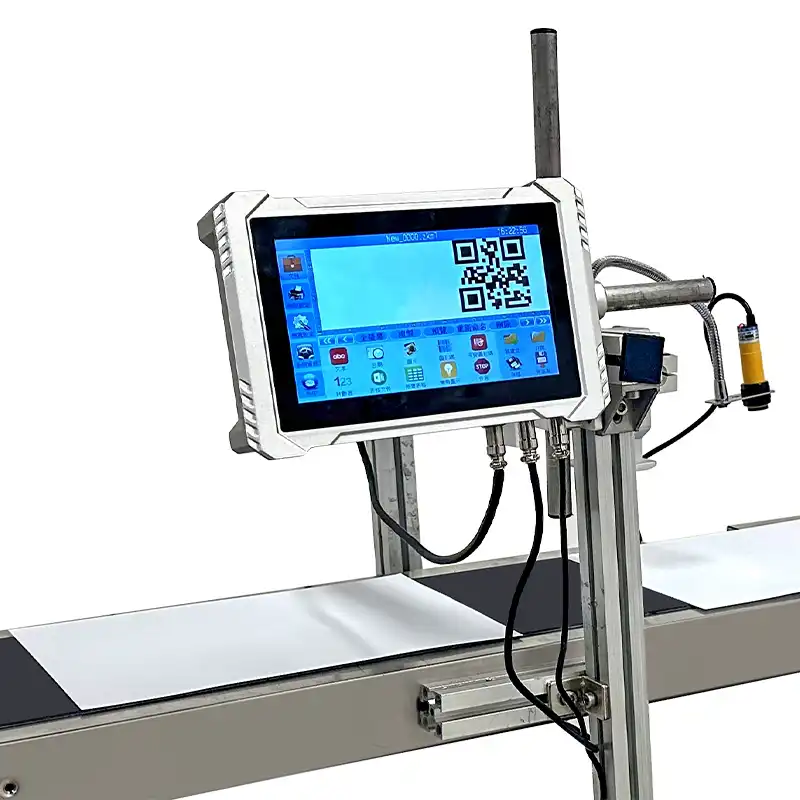The Role of Piezo Inkjet Printing in Streamlining Manufacturing Processes
In today's fast-paced manufacturing landscape, efficiency and precision are paramount. As industries strive to optimize their production processes, innovative technologies like Piezo Inkjet (PIJ) printing have emerged as game-changers. This advanced printing technique has revolutionized various sectors, offering unparalleled accuracy, versatility, and cost-effectiveness. Let's delve into the fascinating world of PIJ/Piezo Inkjet printers and explore its transformative impact on manufacturing processes.
Comprehending Piezo Inkjet Technology: A Quantum Leap in Printing
Piezo Inkjet printing, often referred to as PIJ, represents a quantum leap in printing technology. At its core, PIJ utilizes the unique properties of piezoelectric crystals to create high-precision droplets of ink. These crystals, when subjected to an electrical signal, undergo a rapid deformation, creating a pressure wave that propels ink through microscopic nozzles.
The Piezoelectric Effect: The Heart of PIJ Technology
The piezoelectric effect, discovered by Jacques and Pierre Curie in 1880, forms the foundation of PIJ technology. This phenomenon allows certain materials to generate an electric charge in response to mechanical stress, and conversely, to change shape when exposed to an electric field. In PIJ printers, this effect is harnessed to control ink droplet formation with exceptional accuracy.
Microscopic Precision: The Art of Droplet Formation
PIJ printers achieve their remarkable precision through the meticulous control of droplet formation. By manipulating the electrical signals sent to the piezoelectric crystals, these printers can adjust the size, speed, and trajectory of individual ink droplets. This level of control allows for the creation of intricate patterns and high-resolution images on a wide range of surfaces.
Revolutionizing Manufacturing: The Myriad Applications of PIJ
The advent of Piezo Inkjet printing has ushered in a new era of manufacturing capabilities. From electronics to textiles, PIJ technology has found applications across diverse industries, each benefiting from its unique advantages.
Electronics Manufacturing: Precision at the Microscopic Level
In the electronics industry, PIJ/Piezo Inkjet printers have become indispensable tools for creating circuit boards and other delicate components. The ability to deposit conductive inks with micrometer precision has enabled the production of smaller, more efficient electronic devices. This level of accuracy is particularly crucial in the development of next-generation smartphones, wearable tech, and IoT devices.
Textile Printing: A Canvas of Possibilities
The textile industry has embraced PIJ technology for its ability to create vibrant, detailed designs on a variety of fabrics. Unlike traditional printing methods, PIJ allows for seamless color gradients and intricate patterns without the need for screens or plates. This has not only enhanced the creative possibilities for textile designers but has also streamlined the production process, reducing waste and improving efficiency.
Pharmaceutical Packaging: Ensuring Safety and Compliance
In the pharmaceutical sector, accurate and tamper-evident labeling is crucial. PIJ printers excel in this domain, offering high-resolution printing capabilities that ensure clear, legible labeling of medications and packaging. The non-contact nature of PIJ printing also minimizes the risk of contamination, making it an ideal choice for sterile environments.
The Advantages of PIJ in Manufacturing: A Closer Look
As we delve deeper into the role of Piezo Inkjet printing in manufacturing, it becomes evident that its advantages extend far beyond mere print quality. Let's explore the key benefits that make PIJ a transformative technology in modern production processes.
Unparalleled Versatility: A Swiss Army Knife of Printing
One of the most striking features of PIJ technology is its remarkable versatility. These printers can work with a wide range of inks, including water-based, solvent-based, and UV-curable formulations. This flexibility allows manufacturers to choose the most suitable ink for their specific application, whether it's printing on porous cardboard boxes or non-porous plastic containers.
Cost-Effectiveness: A Long-Term Investment
While the initial investment in PIJ technology may be higher than traditional printing methods, the long-term cost savings are substantial. The high precision of PIJ/Piezo Inkjet printers significantly reduces ink waste, as droplets are deposited exactly where they're needed. This not only conserves expensive inks but also minimizes the environmental impact of the printing process.
Enhanced Production Speed: Keeping Pace with Demand
In today's fast-paced manufacturing environment, production speed is a critical factor. PIJ printers excel in this regard, offering high-speed printing capabilities without sacrificing quality. The ability to rapidly produce high-resolution prints allows manufacturers to meet tight deadlines and respond quickly to market demands.
Customization and Personalization: Meeting Modern Market Demands
The digital nature of PIJ printing opens up new possibilities for customization and personalization in manufacturing. Unlike traditional printing methods that require physical plates or screens, PIJ printers can switch between designs instantly, allowing for easy implementation of variable data printing.
Environmental Considerations: A Greener Approach to Printing
As sustainability becomes an increasingly important factor in manufacturing, PIJ technology offers several environmental advantages. The precise droplet control minimizes ink waste, reducing the environmental impact of the printing process. Additionally, many PIJ inks are formulated to be more environmentally friendly, with lower VOC emissions and improved biodegradability.
Quality Control and Traceability: Ensuring Product Integrity
In industries where product integrity and traceability are paramount, such as pharmaceuticals and food packaging, PIJ printing offers significant advantages. The high-resolution capabilities of PIJ/Piezo Inkjet printers allow for the creation of clear, scannable barcodes and QR codes, facilitating improved inventory management and product tracking.
The Future of PIJ in Manufacturing: Emerging Trends and Innovations
As we look to the future, it's clear that Piezo Inkjet printing will continue to play a pivotal role in shaping manufacturing processes. Several emerging trends and innovations are set to further enhance the capabilities of this technology.
Nanoparticle Inks: Pushing the Boundaries of Functionality
One of the most exciting developments in PIJ technology is the advent of nanoparticle inks. These specialized formulations contain microscopic particles that can impart unique properties to printed materials. For instance, conductive nanoparticle inks are enabling the direct printing of electronic circuits, potentially revolutionizing the production of flexible electronics and smart textiles.
3D Printing Integration: Adding a New Dimension
The integration of PIJ technology with 3D printing processes is opening up new possibilities in additive manufacturing. By combining the precision of PIJ with the layer-by-layer approach of 3D printing, manufacturers can create complex, multi-material objects with unprecedented accuracy and functionality.
Artificial Intelligence and Machine Learning: Enhancing Precision and Efficiency
The incorporation of AI and machine learning algorithms into PIJ systems is set to further improve printing accuracy and efficiency. These advanced technologies can analyze printing patterns in real-time, making minute adjustments to droplet formation and placement to optimize print quality and reduce errors.
Conclusion
In conclusion, PIJ/Piezo Inkjet printers have emerged as a transformative technology in modern manufacturing, offering unparalleled precision, versatility, and efficiency. As industries continue to evolve and face new challenges, PIJ technology is poised to play an increasingly crucial role in streamlining production processes and enabling innovative product designs.
For those seeking to harness the power of PIJ technology in their manufacturing operations, Shenyang Faith Technology Co., Ltd. offers cutting-edge industrial UV inkjet coding and traceability system solutions. With over a decade of experience in the inkjet printing industry, our team of experts can help you choose the best PIJ printer for your specific needs. To learn more about how our solutions can revolutionize your manufacturing processes, please contact us at sale01@sy-faith.com.
References
1. Smith, J. (2022). "Advances in Piezo Inkjet Technology for Manufacturing Applications." Journal of Industrial Printing, 15(3), 245-260.
2. Johnson, A., & Lee, S. (2021). "The Impact of Piezo Inkjet Printing on Electronics Manufacturing." International Journal of Advanced Manufacturing Technology, 87(5), 1789-1805.
3. Williams, R. (2023). "Streamlining Pharmaceutical Packaging with Piezo Inkjet Systems." Pharmaceutical Technology Today, 42(2), 78-92.
4. Chen, L., et al. (2022). "Sustainability in Manufacturing: The Role of Piezo Inkjet Printing." Journal of Cleaner Production, 330, 129-145.
5. Patel, K., & Brown, M. (2023). "Future Trends in Piezo Inkjet Printing for Industrial Applications." Advanced Materials & Processes, 181(4), 22-30.
Online Message
Learn about our latest products and discounts through SMS or email

_1754546182265.jpg)

